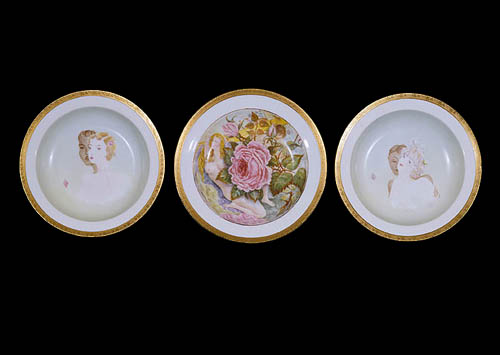


Three hand-painted
porcelain plates, ca. 1934
Central plate 8 inches in diameter; flanking plates each 7 5/8 inches in diameter
All three plates individually signed with a monogram: "F.St."
Provenance:
E. Finley Thomas, Williamsport, Pennsylvania (gift of Florine Stettheimer)
Robert Thomas, New Hope, Pennsylvania (by descent)
The Orange Chicken, LLC, New York
Gina Puzzuoli, MD, Charleston, West Virginia
Francis M. Naumann Fine Art, LLC, New York
These plates were heretofore unknown in the literature on Florine Stettheimer, including the most recent retrospective exhibition, “Florine Stettheimer: Manhattan Fantastica,” organized by Elisabeth Sussman and Barbara Bloemink for the Whitney Museum of American Art in 1995.
Both the style and subject matter of these plates would indicate that they were made fairly early in Stettheimer’s career. Because they were painted on the facing side of rare and fairly expensive gold-edged Bavarian china, it is likely that they were made in the years when the artist lived and worked in Germany. She occupied a studio in Munich in 1913, but when the war broke out in the fall of 1914, she and her entire family returned to New York. If this supposition were correct, and the plates were painted in this early period, then the style they employ—a intentionally naïve yet simultaneously sophisticated manner of painting (particularly evident in the figures depicted on the two flanking plates)—could very well represent the first appearance of an approach to painting that, in years to come, Stettheimer would embrace and refine, so much so that it would eventually represent the hallmark of her mature style.
Since the two flanking plates are marked with a diamond (left) and spade (right), it is logical to assume that Stettheimer may have made two other plates bearing symbols of hearts and clubs, thereby completing the four suits in a card set, although, if made, these other plates have never been recovered.
Whatever their intention, it is difficult to relate card-playing symbols with the subject depicted on the central plate: a magnificent oversized red rose covers the body of a recumbent nude female figure. Behind the heard of this figure can be seen an unopened rose bud, contributing to a screen of foliage that covers the figure of a naked boy who seems to be running off into the far background. Given the other elements in this composition, we could speculate that this boy represents Cupid. He does not banish an arrow, however, but, quite curiously, carries on his back a large wooden crucifix. How such a potent religious symbol figures in the iconography of this image is revealed on the verso of the plate, where Stettheimer has attached a sheet of paper on which appears one of her typewritten poems:
Dear Critic :-
This awkward (?) “position” of
my “Love” – is like a
petition, to Zeus above.
You wonder why thus twisted her limbs and torso?
‘cause she hates the cross, the
“boy” wears ‘addosso’ --,
like Adonis: at play he chided Venus –
off’ring herself, ‘gänzlich ent- / kleided.’
Und was die Kunst anbelangt, mir vor
Vergleichen mil Grossen nicht / bangt.-
Seht Tizian’s “Raub der Europa” an :
da ist ein Englein, verdreht im / wahn.
F. St.
Translation: ‘completely un / dressed.’ And, as far as art is concerned, I am not Look at Titian’s “Rape of Europa”: F. St. |
If we follow the suggestion provided in the last line of this poem and examine Titian’s Rape of Europa (Isabela Stewart Gardner Museum, Boston), we will find a little angel in the lower-left corner of the composition whose body twists awkwardly as he grabs the dorsal fins of a fish and tries to stay afloat, all the time looking upward at Europa who rides off on the back of bull (who is, of course, Jupiter in disguise). In her poem, Stettheimer clearly asserts that she does not object to her work being compared with the great artists of the past; indeed, she tells her critics (the poem is address “Dear Critic”) to look at this painting by Titian to see similar distortions in his figures.
The poem also provides a note of personal information that might account for the awkward positioning of her Venus: “she hates the cross the boy wears adosso.” If we take these words at face value, then Stettheimer might have envisioned herself as Venus, her limbs and torso twisted in response to the cross-bearing child: she is, in effect, literally bent out of shape, because—as a young Jewish woman—she feels that the Christian themes and subjects she encounters on a regular basis in the churches and other public buildings in Bavaria ignore the religion of her forbearers. As a child, Florine and her sisters attended mass and other religious ceremonies in the company of their Irish Catholic nurse, Margaret Burgess. In another poem that Florine wrote about Miss Burgess, she recalled that her nurse was introduced to the art of sculpture by a statue of God that she had seen in a chapel. Although the Stettheimers were not practicing Jews, it is possible that the children might have felt that such an overabundance of Christian imagery was, at best, stifling, at worst, visually oppressive.